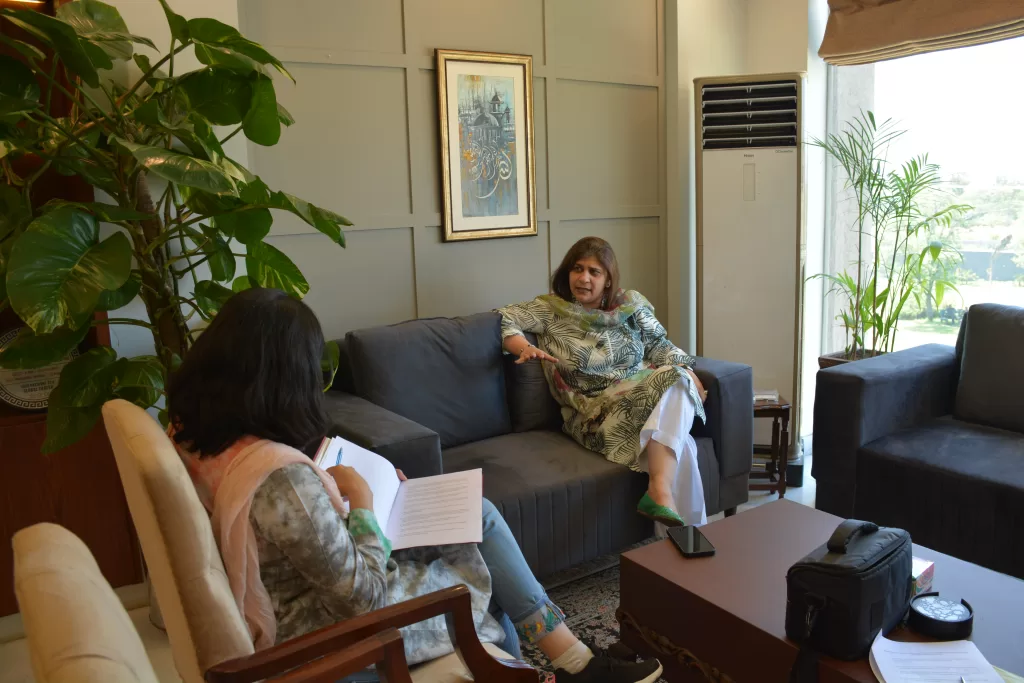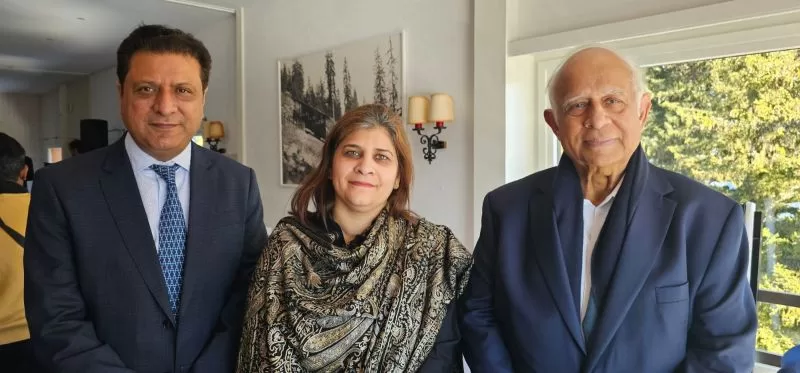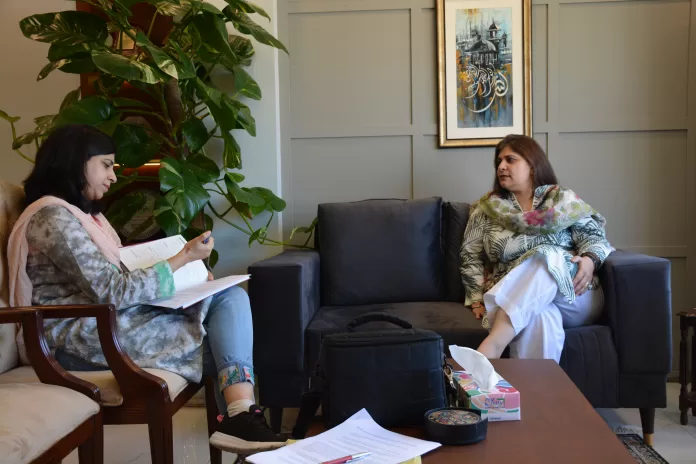Tell us about your educational background, and what motivated you to join NAVTTC?
I am a psychologist. I have worked in the sub-sectors of drug rehabilitation for children battling abuse and women in distress. I am also interested in civic education and I also have a degree in governance. Then I joined the development sector. I have tried that my mental health interests and my governance interests are synchronized. If you look at my professional path and also at my career, you find that they are always coordinated. So, when I was working in the late 1990s at Shifa Hospital as a consultant psychologist, I was at the same time, very active in civic education. I have also worked with a German political Foundation that was interested in inculcating citizenship values among young people. I am also a trained trainer and facilitator from the International Academy of Leadership in Germany and till December 2023, I used to go and train at my alma mater at least thrice a year. I have worked in Romania, Bulgaria, India, the US, Nepal, Sri Lanka, and the Maldives. In 2005, I also founded a private nonprofit consulting company that specializes in governance, media reforms and technical skill building. And under these sectors, I worked with the prosecutors, with the judicial academies, with the police, with women in distress, with children, with media and content analysis. I did quite a bit of production and audio-visual work. I’ve just briefly sketched out my entire experience in the private and development sectors.
The idea is that we should work with young people and focus on their technical and skill-building. The issue was that we could only pilot things, we could only move to a certain level. But then it came to the idea of replication or policy reforms, I’ve been very active with the youth policies initially, before the 18th Amendment with the federal government, and then after the 18th Amendment with federating units. The issue was that I was unable to come up with anything tangible in the policy reform framework. So, when this opportunity came along at NAVTTC, I availed it because this was a small window where I felt the policy reform stream could be channelled and mainstreamed.
Can you provide an overview of NAVTTC’s mission and objectives, and how they align with Pakistan’s broader educational and economic goals?
NAVTTC is a regulatory body. There are more than 5,783 technical and vocational training institutes in Pakistan, This includes the public sector as well as the private sector. NAVTTC itself does not have any institute of its own except the neighbouring center of excellence, which is right next to our head office in Islamabad. We do not have any kind of training institute of our own anywhere in the country. Primarily because our mandate is regulation and to ensure that whatever technical training skill is imparted in this country, it should be of quality. Now at the same time, we were established under the law in 2011 and we are aligned with the Federal Ministry of Education but our organization comes under the Prime Minister’s office too. When the Federal Government feels that in terms of marginalized geographical areas or demographics that an affirmative action is needed then that is where the NAVTTC comes in. But somehow that role has become larger as compared to the regulatory. So my struggle is also that we are equally cognizant of the fact that we are a regulatory body and we should regulate, so the idea of quality control should also be there.
In terms of technical and vocational skill training, there is a mindset that people want their children to have university degrees, which is very good. But anything hands-on, that is skill-based, at worst you look down upon it, and at best you are very condescending about it. So the idea is to bring a change in this mindset which I am very eager to bring about, and the fact that I keep talking about this at every forum, when we talk about jobs of tomorrow and jobs of today, we need these competencies, which is also a life competency. I mean if I want to change my electricity bulb then I don’t need to make someone come and change it, I should be able to change it myself. If my UPS is not working, I should be able to fix it myself. We have done a couple of things to change this mindset. First, in the curriculum, technical and vocational education is discussed in different subjects. But the technical and vocational training skill segue that you get, is absent. So, I requested the National Curriculum Wing and they were kind enough to take on my suggestion that we have to put three or four small lines about infographics, a box somewhere about some skills in our curriculum. We have to put them in the six subjects that we have identified so that the child, or the girl, can get a social interjection from that. This will help them learn that if they have to acquire a skill like an electrician, plumbing, industrial trade, or high-end IT, then they should know how to do it.
At the same time we are also working on the idea of an entrepreneurship program for the TVET sector. You see, governments are everywhere, I am not just talking about us, Governments everywhere in the world can no longer employ all their citizens with jobs in the public sector. You see historically, innovation comes from the private sector because they can risk it, also we cannot put public money at risk. So, we should encourage an entrepreneurial mindset from the beginning. For example, if somebody is making a table, he/ she should think if I am making this table and I am making a design of it, how I can bring some innovation to its design to make it more marketable. Now, that kind of experimentation can only come from an entrepreneurial mindset.
In a report published in 2016 by the British Council, it was found that there was a gap between, industry and skill institutions in Sindh Province. There are more than 500 skill institutions in Sindh. The main idea was to determine if the students were aware of the subject matter being taught and its practical implications. Industries have a high demand for specific skills that graduates lack. English proficiency is preferred, but students are unaware of this requirement. The curriculum is outdated and does not align with job market needs. I guess this is the same situation in entire Pakistan. What’s your take on that?
I think, we are comparing Apples and Oranges. The curriculum used to be outdated. Because we are now talking about skills it is a trade-specific curriculum. We have the National Curricula Standards Board under which we have revised the curriculum because our curriculum has not even been revised for a long time. We’ve got a total of 413 trades, of which 128 are active and in almost all the trades, we updated the curriculum last year and this was before I joined. There is another problem of misinformation and disconnect between different stakeholders in the skill industry. I was hosting a delegation of the Islamabad Industrial Association for Planning to arrange some job fairs with them. There is such a disconnection between NAVTTC and the industry that when I asked them to give paid internships to our graduates, they said they would interview students first and then decide. Then I asked them to guarantee a minimum employment for me and they agreed on this. When I asked them whether they had taken a look at the curriculum the concerned person said, ‘No I haven’t but I’m sure it is outdated.’ His confidence regarding the outdated curriculum was disturbing to me. So my point is that there are several battles that we are fighting. One is this complete disconnect between the government and the private sector, both view each other with suspicion. I have this unique position that I am working within the government but I belong to the private sector so I can act as a bridge between them. There are organizations to whom I approached and asked them to come in and give us feedback on the newly developed curricula and tell us if it is relevant to their industry but they were not interested in responding. Even then I still approached them and ensured facilitation in every possible way if they wanted. We have three trade categories, the conventional trades, the industrial trades, and the IT trades. In IT trades we don’t have to make the curricula ourselves. We have the already established curricula of Amazon, Google, etc. We have improved the curricula in the other two categories, and I am very eager to connect the curricula with the industry here, which is our actual market and our actual customers. I want to share the curricula with them so that they can give us feedback and some sort of mechanism could be established about it. Curricula theory is one thing and on-the-job training is another thing. So, we are establishing industry linkages and we have signed MoUs with the Federation of Pakistan Chamber of Commerce (FPCCI), other chambers and industrial associations so that our graduates would be paid for on-the-job training. Every country, even Bangladesh, India and Nepal is doing this in-house training with education.

How does NAVTTC support marginalized groups and their inclusion, such as women, persons with disabilities, and rural populations, in its programs? What measures has NAVTTC taken to encourage the participation of women in vocational and technical education?
I will give you an example of the course that is currently going on. It represents all communities and persons with disabilities are also included. In Balochistan, 9,000 students are enrolled including transgender and women, we do not discriminate on any basis or based on gender, ethnicity, or ability.
Tell us about Gender Discrimination at the first point where girls/ women are only allowed to learn a few typical courses.
This is not the case. I disagree with the word ‘allowed’, any Pakistani citizen can enroll in any NAVTTC course if they pass the entry test, whether they are men, women, or transgender. Some women prefer the so-called perception that some courses are not allowed for them.
In some courses, more women are allowed and, in some courses, there are more men. This perception is not created by NAVTTC but it is a perception already present in people’s minds. To address this perception we have launched a course called ‘SheFixes’ on March 8th, 2024. We have enrolled women in the so-called male-dominated courses like plumbing and building. We started it as a pilot course but now we are regularizing it.
What does women’s empowerment mean to you?
For me, women empowerment is when a woman has the authority over her resources, her voice, and her choice, whether she wants to work inside the house or outside the house. What we are trying to do is that these women can conduct themselves as role model for the other younger women out there and also help themselves in shaping their careers. We launched ‘SheFixes’ for this purpose.

& Ikram Sehgal, Co-Chairman, Pathfinder Group
What role does technology play in enhancing vocational and technical education, and how is NAVTTC leveraging digital tools and platforms for this purpose?
Technology is very important and necessary and I would say that without technology it is not possible to even think about a job. We are bringing AI, Simulation, and Gamification into our traditional so-called conventional courses so that we can dispense more and more learning and training. In NAVTTC, we have IT courses also, like high-end IT, and high-tech IT, and these courses are running right now.
NAVTTC has a network of training centers across Pakistan. How does the organization ensure equitable access to training opportunities, especially in remote and underserved areas?
NAVTTC does not have a single center of its own, this is a wrong perception of NAVTTC out there because it is a regulatory body only. It regulates the technical and vocational training being conducted either in the public sector or private sector. NAVTTC oversees the standardization, certification, and accreditation of these technical and vocational trainings. In some geographical areas and marginalized demographics, through affirmative action, we fund other training institutes to run NAVTTC’s courses. In the provinces, there are public and private training institutes and provincial TVETS are our affiliate partners who run these programs.
What challenges does NAVTTC face in achieving its goals, and how do you plan to address these challenges?
There are many challenges. The idea is that the training should be of a certain standard. We are focused on employability and we are revising and rethinking many courses to focus on employability. This is our goal and this is our challenge. Also, the idea is that in NAVTTC we should promote lifelong learning and for that, I am trying to design courses by introducing the notion of flipped classrooms.
In our educational system, in classrooms you were first given theoretical and then practical knowledge. Now, we are trying to modify it in a hybrid form so that students can learn online. First, you give them an orientation, check their appetite and their interests, and then bring them to the classrooms. This is going to be our approach. We are also establishing international linkages so that we can create links as a federal government regulatory body for the different training institutes in the country, with our international counterpart countries like the KSA, UK, UAE, and others, so that our certificates are recognized.
What strategies and initiatives have NAVTTC implemented to increase awareness and engagement with its target audience, particularly given the initial lack of recognition and coordination challenges you mentioned?
There are serious issues. I continuously inform others that our target audience remains entirely unaware of our presence. When I was appointed as Chairperson NAVTTC, you won’t believe but many people, including my friends started congratulating me saying that now our films will be good. NAVTTC has nothing to do with the entertainment and film industry, so you can imagine the disconnection that is there. The people who are in touch with us, in my opinion, are not our target audience. After the 18th Amendment, our affiliate partners, the Provincial TVETs are independent. We can regulate them but they have their courses and they operate independently of us. And also, there was no coordination in that. So, I established a TVET Steering Coordination Committee, in which we put people from all the Technical Education & Vocational Training Authorities (TEVTA’s) so that we would at least meet twice in 3 months, once in person and then once virtually so that we get to know what is happening in Sindh and what is happening in Balochistan, the B-TVETA was completely inactive. It was not even there. I activated that.
So, we started from these little procedural things, which were a lot. For that bigger picture, to achieve that bigger goal, you have to set up your path. For example, if you and I are not arguing about making something better, then how can we coordinate an effort about it? And then the other issue is, we try to hide things and say everything is fine. If everything is fine, why are we here? But in NAVTTC, we are focused and it is open for business. If you have private parties, including trading institutes and if you have an idea, we would like to fund those ideas while focusing on employability rather than giving away 200 seats here, 20 there, for a mere quota without any outcome, since 2011, that is not working so it has to be stopped.
What message or advice would you like to share with young people aspiring to pursue careers in vocational and technical fields?
I want to say three things, speaking directly to the young persons. Firstly, you will make more money if you acquire a skill. Secondly, for the young person who has never been to school or college, but has been working as a shagird (informal learning of a skill) or as a labourer somewhere, you can contact NAVTTC, and we will give you a certificate. We have a program called Recognition of Prior Learning (RPL), the fee for which will be paid by NAVTTC, you don’t have to pay a single penny, and after accessing whatever skill you have, we will give you a certificate. And that certificate will help generate more employability opportunities for you. Thirdly, we will be launching the TVET entrepreneurship cohort. Where, if you think that you have an innovative idea, you should apply and we will support you. We will give you a mentor, and an ecosystem and we will give you the initial funding. Then we will help you ideate and we will do it for four months. After that, we will train you for seven months, and then we will incubate your idea further.





